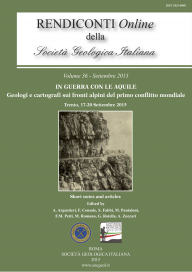
Umberto Nistri, il Genio italiano e lo sviluppo dell'aerofotogrammetria
Giovanni De Caterini & Paolo Zaffiro
(a) Engeo Praxis S.r.l. Via di Donna Olimpia, 166 - 00146 Roma. E-mail: giovanni.de.caterini@gmail.com
Volume: 36/2015
Pages: 60-62
Abstract
Umberto Nistri has been one of the forerunners of the aerial photogrammetry. He technically developed the aeroglifo system and, thanks to the great results he obtained, he widely contributed to the success of the flight land surveys. The business and scientific adventure began during the First World War. Umberto and his brother Amedeo gave birth to two societies: S.A.R.A. Nistri and O.M.I.. He was an official in the specialist brigade in the corps of engineers of the army and he was involved as an observing photographer in the 35th air commodore. He used and developed techniques of the photogrammetry with images taken from above. This was first made by Captain Moris who, in 1896, had taken photos from a hot-air balloon, he was the captain of a special branch of the engineering army and, in 1915, he became head manager of air force. Italy led the way in the "tactical" use of the sky, as a matter of fact, in 1919 for the first time, during the Italian-Turkish war, military planes were used for observation and bombing.
After the war, in 1919, Umberto patented the first "device to obtain topographic maps from airplane stereoscopic photographs". At the beginning of the '20s, together with the corps of military engineers and other excellences in the field, Umberto Nistri gave a great contribution to the aerial photogrammetry as the main device for topographic survey.
Keywords
Get Full Text